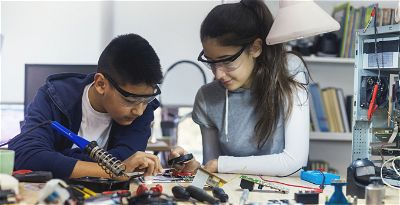
Hypothesis: K-12 Partnerships
October 1, 2020
Strong Partnership and Alignment with Local K-12 Schools and Districts
Designs for equitable pathways begin in high school, when it is critical to introduce young people to a continuum of career-related experiences. Some intermediaries also work with middle schools to introduce youth to broad career options and professional culture.
Intermediaries support schools and districts to ensure that career-connected learning and work-based learning opportunities expose youth to career options that can have a lifetime of impact. Strong partnerships and alignment include work-based learning as a core component of career pathways with solid participation of youth who are Black, Latinx, or experiencing poverty, and no group is over- or underrepresented in a particular program or with a particular employer. Career pathways integrate rigorous core academics, career-focused learning, and work-based learning. Data systems track outcomes and use data for program evaluation and improvement.

Spotlight: Brooklyn STEAM Center, Brooklyn Navy Yard
In 2018, the Brooklyn Navy Yard began a partnership with the New York City Department of Education to launch the Brooklyn STEAM Center. The Brooklyn STEAM Center provides high school students with career and technical training and connects them to internships with employers in related fields that have businesses in the Navy Yard. The Brooklyn STEAM Center is an example of an intermediary that both coordinates pathways work behind the scenes and provides direct education programming to students. With this model, work-based learning, academic, and career-training experiences are all aligned and build upon one another in a way that helps students create paths to successful and meaningful futures.
The Brooklyn STEAM Center works with eight area high schools to serve approximately 300 students in grades 11 and 12. Ninety-three percent of participating students are Black or Latinx and 74 percent are eligible for free or reduced lunch. Every day for half a day, students hone their knowledge and skills through pathways in culinary arts, computer science, construction technology, design and engineering, and film/media. Students fulfill high school requirements while earning industry certifications and college credit. The program also helps students develop relationships in their fields of interest with employers at the Navy Yard that may hire them when they complete their programs.
To make this complex set of relationships work, the Brooklyn STEAM Center facilitates bimonthly meetings with the school partners to recruit new students, share information, and coordinate academic work, training, and work-based learning. They also collaborate on reviewing student progress data and share strategies to accelerate freshmen and sophomores through their core academics to make sure they can participate as juniors and seniors. The Brooklyn STEAM Center and its high school partners also work together to schedule students’ classes to support their participation.
Spotlight: HERE to HERE
Since HERE to HERE was founded in 2017, the organization has brought together employers, K-12 and postsecondary educators, and community-based organizations with the goal of creating work-based learning experiences for young people in the Bronx and New York City. Most importantly, HERE to HERE makes youth voice a priority and keeps diversity, equity, and inclusion front and center. The HERE to HERE Language Guide: A Resource for Using Asset-Based Language with Young People is a good example of this priority in action.
HERE to HERE believes that work-based learning should be incorporated into every student’s high school and postsecondary experience. But it is often challenging for high schools to develop and maintain connections with local employers. To support students, the majority of whom are Black and Latinx, in its 15 partner Bronx high schools, HERE to HERE works with high schools, community-based organizations, and local employers to place youth in work-based learning opportunities. By prioritizing placement opportunities, HERE to HERE supports high schools in connecting with employers and provides employers with an efficient “go to” organization for finding eligible young people.
Through its Work-Based Learning Labs, HERE to HERE helps partners develop high-quality work-based learning experiences that lead to strong outcomes. HERE to HERE is also working with its partners to codify quality standards of practice in its Key Distinguishers for high schools, postsecondary programs, employers, and paid work experiences. For example, in response to the need to provide work-based learning opportunities remotely during the pandemic, HERE to HERE developed Key Distinguishers for Virtual Paid Work Experiences. The Key Distinguishers also provide a framework to support high-quality work-based learning along dimensions of youth engagement, school staff and infrastructure, external partnerships, assessment, and accountability.
Click on the icons below to learn about the other five hypotheses and read spotlights that illustrate how the Building Equitable Pathways partners took on this work. The spotlights are intended to show theory in action and to support new intermediaries as they tackle the challenge of building equitable pathways that promote young people’s college and career success.
Postsecondary Partnerships
Strong partnership and alignment with local postsecondary institutions
Alignment with Labor Market Demands
Articulated paths aligned to local labor market demands
Employer Partnerships
Strong partnership with the local employer community to advance opportunities for work-based learning
Sustainability
Sustainable business model
Policy
Policy agenda and supporting strategies

Building Equitable Pathways
Building Equitable Pathways is a community of practice working to create equitable pathways systems so that more Black and Latinx youth and young people experiencing poverty succeed in college and their future careers. Building Equitable…

Equitable Pathways Hypotheses Spotlights
The Building Equitable Pathways hypotheses guide the development of pathways that equitably support all young people, especially youth of color and youth who are experiencing poverty, in building rewarding and successful futures. Learn what the…